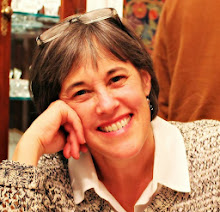 |
| Buffy the Eggs-Layer |
 |
| Elvis the King |
On March 26, 2008 we purchased 10 Dominique pullets. They were only four days old! One biddy died the first night.
The rest survived and grew into beautiful black and white barred hens that still provide us with delicious brown eggs. These hens all look the same to me. I call them 'the Girls'.
 |
| Juvenile Birds |
 |
| Waiting for Sue |
In the summer of 2009 our son, Andrew, bought two Barred Rock biddies with the intention of taking them to the house in Asheville. Alas, the chicken coop never got built, and these two hens were incorporated into our small flock. At the same time, Rouse bought three Pekin ducklings, with the intention of putting them on the pond. Abi's dog, Grayson, was a frequent visitor and very interested in our little birds. For safety purposes, we kept the ducks in the chicken yard. They made a stinky mess! Always playing in and fouling their water. Grayson finally did kill one of the ducks. I ended up giving the other two to my friend, Betsy.
 |
| Check out the rose combs |
On September 15, 2009 we lost Elvis the King. Grayson the Granddog was overcome by instinct and did him in.
 We decided we'd like to try to raise our own chicks, but we needed a rooster. Rouse tried unsuccessfully to acquire a mature Dominique cock. Finally, in March of 2010 we decided to start from scratch. We bought a baby Dominique rooster and one biddy to keep him company.
We decided we'd like to try to raise our own chicks, but we needed a rooster. Rouse tried unsuccessfully to acquire a mature Dominique cock. Finally, in March of 2010 we decided to start from scratch. We bought a baby Dominique rooster and one biddy to keep him company.This is the wire mesh structure we use to keep our young chicks safe while enjoying some outdoor time in the grass. Once they graduate to the chicken coop, we continue to use this little cage to keep them separated, as needed, from the older hens.
It was a big day when we heard our young rooster crow for the first time! We named him Barack (pronounced with a chicken accent) because he's black and white. He and his brood-mate, First Lady, were best friends during their youth, until Barack took his place as leader of the flock.
 |
| Barack and First Lady |
We lost five hens in 2010. In May, one of the girls died from complications of egg yolk peritonitis. On June 22 I found a chicken dead in the safe zone ... no explanation of death. On October 1 we lost a hen to an unidentified illness. I found her in the chicken yard on her side. She couldn't stand up. Rouse (thankfully) put her out of her misery. On October 5 Grayson the Granddog mortally injured a hen while in training to leave the chickens alone. On November 23 we lost a hen to a hawk attack.
In spring of 2011 we had seven hens left... First Lady, along with 6 of the original 9 Dominique hens. Egg production dropped as these girls entered their fourth laying season. And they showed no sign of going broody! It was time to replenish the flock.
On April 1, we brought 8 biddies home from the feed and seed store ... 4 Dominique pullets and 4 Ameraucana pullets. These little girls grew quickly, and soon it was time to move them to the chicken house.
We settled them under a wire mesh cage until we could get a dedicated space set up for them in the "safe" zone. That required building a small chicken coop (compliments of Rouse), shoring up the rusted out chicken wire fence (yours truly), and building a gate to separate the biddies from the more mature hens (thank you, Drew).
The new space worked great! The chicks could really spread their wings, safe from inclement weather, from predators, and from the curiosity and pecking order of the mature hens.
Inside the shelter they had roosts, food, water, and a heat lamp. Outside, more water and "goodies" such as chickweek and grass that had gone to seed - provided by their generous benefactors - all within a safely enclosed area. Plus, there were stumps that provided for great play and entertainment. Best of all, I didn't have to move them in and out of the hen house morning and night.
These little chicks went out to play ... the other five were scared back into the shelter by the big person with the camera! The Ameraucanas outgrew the Dominiques early on. Pretty scraggly here, their feathers were beginning to replace chick fluff. So cute!
In May, one of the old chickens died while I was vacationing in Europe with my parents. It was expected. She had been feeling poorly.
On July 11 I allowed the biddies to leave their nursery to join the more mature hens in the chicken yard. On August 11 the young Dominiques started laying. One month later (09/10) I picked up our first little blue Ameraucana egg.
On October 1, 2011 we crossed the line ... we harvested one of our chickens for meat.












